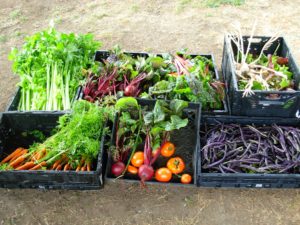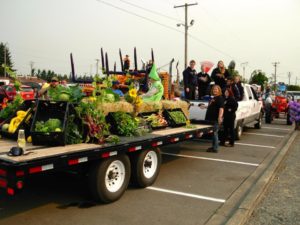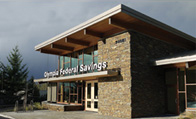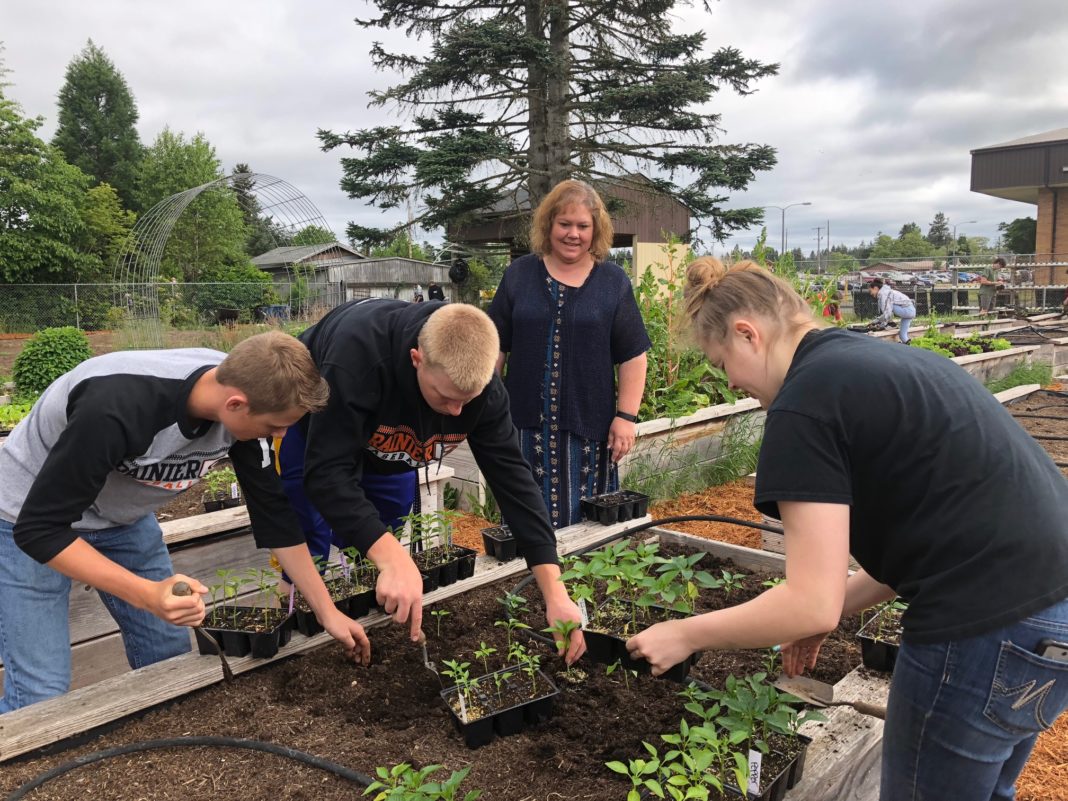If kids are hungry, feed them, but also teach them how to grow their own food. That is Angie Karnes’ approach to the Rainier Community Garden. The students in her landscaping class at Rainier High School learn all phases of growing a garden, from planning to planting and tending to harvest. It’s all hands on.
 The class works outside in two green houses. Then just before school lets out for summer, they plant their starts in raised beds next to the high school. Over the summer, the garden is tended by volunteers led by Angie or another knowledgeable gardener. Several students earn volunteer hours working in the garden during the summer, but volunteers of any age and level of experience are welcomed. They hold work parties on Saturdays through the growing season. “When the garden really gets going, we harvest on Wednesdays too,” shares Angie. The work parties and harvests are timed to coincide with the hours of the Rainier Food Bank.
The class works outside in two green houses. Then just before school lets out for summer, they plant their starts in raised beds next to the high school. Over the summer, the garden is tended by volunteers led by Angie or another knowledgeable gardener. Several students earn volunteer hours working in the garden during the summer, but volunteers of any age and level of experience are welcomed. They hold work parties on Saturdays through the growing season. “When the garden really gets going, we harvest on Wednesdays too,” shares Angie. The work parties and harvests are timed to coincide with the hours of the Rainier Food Bank.
Each week volunteers harvest what is ready and weigh the produce. A volunteer can take home what they will eat for the week, and the rest is given to the food bank. Sometimes they harvest so much that extra food is given to nearby communities. In 2017, the community garden grew 3,800 pounds of food. Volunteers took home 1,000 pounds and 2,800 pounds went to the food bank. “The Rainier food bank feeds up to 1,200 families a week,” Angie adds.

The garden is a true community project. The school provides the grounds and funds the green house. They used to pay for the water until that proved too expensive. Angie is searching for a grant to cover the water, and until then the water bills are paid from her vocational education budget. Everything else is paid for by grants and community donations. In the summer all labor is volunteered. They harvest on Saturdays and when the garden gets going they add a Wednesday harvest work party. The harvest days coincide with when the food bank is open. “On any given Saturday, we have seven to eight volunteers, but we can have up to 20 people,” says Angie.
At the end of August, the group organizes a float for the Rainier Round-up Parade. That is when the garden is really producing. Instead of handing out candy, they distribute flyers and give away green beans, tomatoes, squash and broccoli.
Angie hosts a community garden potluck meeting one evening a month in her classroom. Community members who attend the meetings help plan projects, classes and special events. “We use the meetings for big decisions about any issues,” says Angie. “For some it’s also a social time.”

The Rainier High School Landscaping Class
For the landscaping students, the year starts out with basic yard maintenance in September. “I really like this class,” says sophomore Florenzio Lugo. “I get to work with a mower and weed eater.” They learn all aspects of tending a yard and garden. From maintaining mowers, changing weed whacker string, to tending the pond, orchard, garden and green house plants, there is plenty to keep all 18 students busy. The class builds camaraderie too. “We help each other out,” Florenzio adds.
Come January, work for the community garden begins. The high schoolers choose what vegetables they like to eat and therefore want to grow, and the food bank also gives input on what their clients are likely to want. The students then plant seeds in the greenhouse, tending the seedlings as they grow and learning about nutrients and plant requirements.
In May, they hold a plant sale to help fund the program. Leftover starts get planted in the community garden. Any starts not used in the garden are given to students to plant at home or are taken to the food bank.

Sami Edminster serves as garden manager and helps direct her classmates as they transplant the seedlings into beds in the garden. Referring to a chart on her clipboard, she sends students to various numbered raised beds as they file into the fenced area with trays of healthy young plants. Sami is a Senior and is just finishing her second year in the landscaping class. “I like working with my hands,” she says, “and working with the plants because it’s really calming.”
Angie mills around the garden answering questions and giving planting pointers. Lessons taught in class about good bugs versus bad bugs are reinforced as the kids work in the dirt. A potato bug is found and returned to the bed as a beneficial bug. Another student appears with a cut worm on the end of his shovel. That one is relocated outside the garden along with any snails or slugs that dare to appear. The beds were loaded with worms earlier in the season, and students call out as they discover the wigglers while digging in the soil.
These students have seen to it that the garden gets off to a good start again this year. Angie is doing the same for her students.
















































